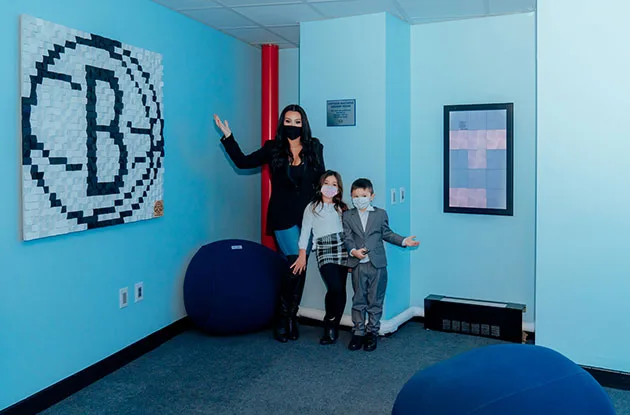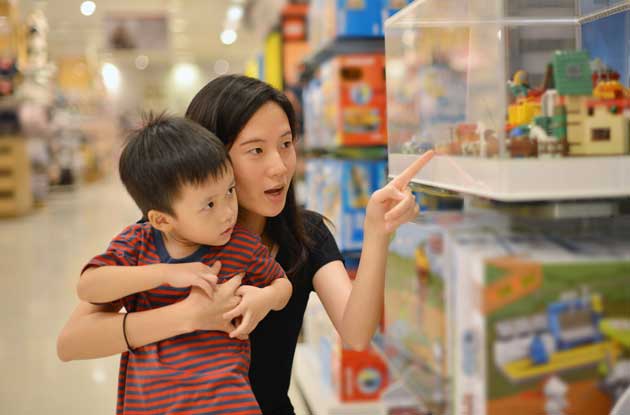UPDATED MAY 29: Spring is in full swing, and it’s brought numerous baby animals to New York City’s zoos, from baby baboons in Brooklyn to a tiny crane chick in Central Park. Get a first look at the newborn animals here, with details on when and where to see them in person.
Gorillas, Lions, Lemurs, and a Giraffe at the Bronx Zoo
After eight years, the Bronx Zoo has welcomed two new baby western lowland gorillas. The babies were born within two weeks of each other to 33-year-old Julia and 19-year-old Tuti. The newborns are the 14th and 15th babies born at the Bronx Zoo and are currently living with the rest of their troop in the Congo Gorilla Forest.
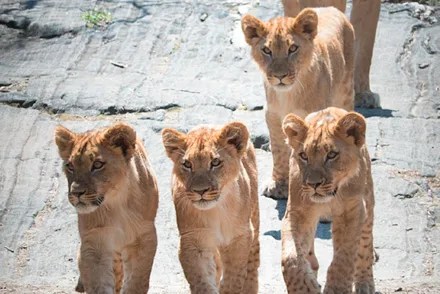
Photo by Julie Larsen Maher
While you’re there, visit the zoo’s African Plains Exhibit, which is formally introducing four lion cubs that were born in August. The litter is made up of three males – Thulani, Ime, and Bashati – and one female, Amara. The lion cubs were bred as a part of the zoo’s Species Survival Plan in an effort to conserve threatened species and to ensure them a promising future.
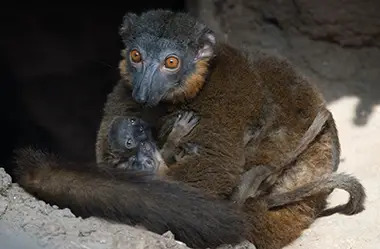
Photo by Julie Larsen Maher
Three brown collared lemur babies are on exhibit in Madagascar! at the Bronx Zoo. The births include a rare set of twins born to mother Vera and father Antoine on April 1. The single baby was born to mother Jakara and father Gerard on April 6. Collared lemurs, which are classified as “Vulnerable” by the International Union for Conservation of Nature, live in groups of males and females but are not matriarchal like many other lemur species. The young ride on their mother’s back hiding in her fur for the first few months of their lives. All three infants like to nestle in their mothers’ fur. They live in the Spiny Forest exhibit in Madagascar! along with ring-tailed lemurs, radiated tortoises, vasa parrots, red fodies, grey-headed lovebirds, crested couas and ground doves.
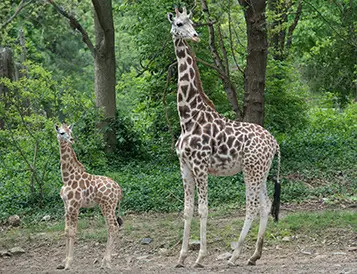
A male Baringo giraffe calf is one of the newest animals at the zoo. The young giraffe was born during the winter and lives in the zoo’s African Plains exhibit. Newborn giraffes are approximately 6 feet tall at birth and can weigh more than 100 pounds. As adults, they can be more than 17 feet tall and weigh more than 3,000 pounds. Giraffes are the tallest animal in the world and have an 18-inch-long tongue that they use to grasp branches and pull leaves from trees. The gestation period for a giraffe is about 14 months. The newborn calf stands and starts walking within the first couple of hours of birth. The calf will nurse for approximately one year, but will begin eating some solid food at 3 months old. Eventually it will transition to a diet of leaves, alfalfa, hay, kale, pelleted grain, and other produce.
Wildlife Conservation Society’s Bronx Zoo
2300 Southern Blvd., Bronx
718-367-1010; bronxzoo.com
Hours: 10am-5pm weekdays, 10am-5:30pm weekends from April through October; 10am-4:30pm November through March.
Cost: $16.95; $14.95 seniors ages 65 and older; $12.95 children ages 3-12; free for children younger than 3. Parking is $15 for cars and $18 for buses.
Hamadryas Baboon Babies at Prospect Park Zoo
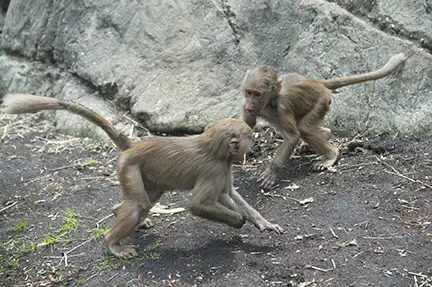
Photo by Julie Larsen Maher
Head to Prospect Park Zoo in Brooklyn to see two young Hamadryas Baboons that were born just under a year ago. The rambunctious pair spends time roughhousing and playing in the zoo’s Animal Lifestyles building.
WCS Prospect Park Zoo
450 Flatbush Ave., Flatbush, Brooklyn
718-399-7339; prospectparkzoo.com
Hours: 10am-5pm weekdays, 10am-5:30pm weekends from April through October; 10am-4:30pm November through March.
Cost: $8; $6 seniors ages 65 and older; $5 children ages 3-12; free for children younger than 3.
Baby Pudu at Queens Zoo
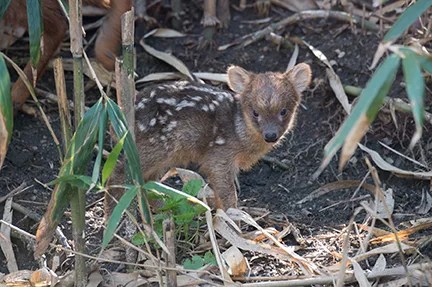
Photo by Julie Larsen Maher
On April 29, the Queens Zoo welcomed a 1-pound southern pudu to its growing family. The female baby pudu weighed only 1 pound at birth and will grow to be a 20-pound adult—it’s no surprise, then, that pudus are the world’s smallest deer species. The southern pudu originates from Chile and Argentina and is part of the zoo’s Species Survival Program. The tiny deer rely on their diet of vegetables and grains to stay up and running and, of course, to welcome their visitors! The pudu can be seen along the zoo’s South American Trail.
WCS Queens Zoo
53-51 111th St., Flushing, Queens
718-271-1500; queenszoo.com
Hours: 10am-5pm weekdays, 10am-5:30pm weekends from April through October; 10am-4:30pm November through March.
Cost: $8; $6 seniors ages 65 and older; $5 children ages 3-12
Snow Leopards and a White-Naped Crane at Central Park Zoo
For the first time in history, the Central Park Zoo welcomes a pair of snow leopard cubs. Born less than a year ago, these cubs are part of the zoos Species Survival Plan, which aids in conserving endangered species like the snow leopards. You can visit these adorable cubs at the Allison Maher Stern Snow Leopard Exhibit.
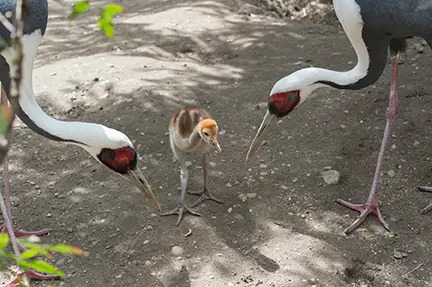
Photo by Julie Larsen Maher
The zoo also hatched a white-naped crane chick in early April. It is the first of its kind to be successfully hatched at this zoo. White-naped cranes are a part of the Wildlife Conservation Society’s Species Survival plan because of their classification as “vulnerable,” making the chick’s birth all the more exciting. The chick can be seen strutting around the zoo’s Temperate Territory alongside its parents.
WCS Central Park Zoo
64th Street and Fifth Avenue, Manhattan
212-439-6500; centralparkzoo.com
Hours: 10am-5pm weekdays, 10am-5:30pm weekends from April through October; 10am-4:30pm November through March.
Cost: $12; $9 seniors ages 65 and older; $7 children ages 3-12
Anteaters and Kangaroos at the Staten Island Zoo
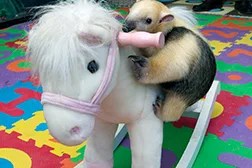
The Staten Island Zoo is making headlines with the birth of its adorable baby tamandua anteater named MJ. MJ is the first tamandua anteater to be born in New York State in more than 20 years. If you want to check MJ out, you can find him in the Rainforest Wing this summer.
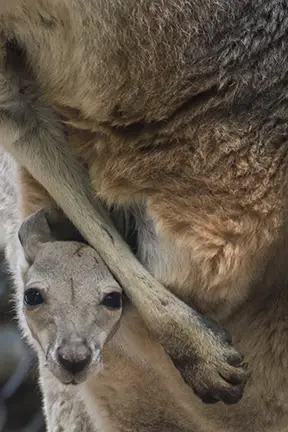
Two new kangaroos, or Joeys, were born at the Staten Island Zoo about five months ago. “Once the Joeys are born, they crawl their way up to their mother’s pouch and stay there for nine or 10 months,” said Kate Karpuck, assistant manager of the zoo’s Children’s Center, where the kangaroos can be found. It is unknown whether the babies are male or female since it is too early for them to fully come out of the pouch. Although they’ll be in their mother’s pouches for a few more months, they can be seen peeking their heads out, greeting the world, and welcoming visitors.
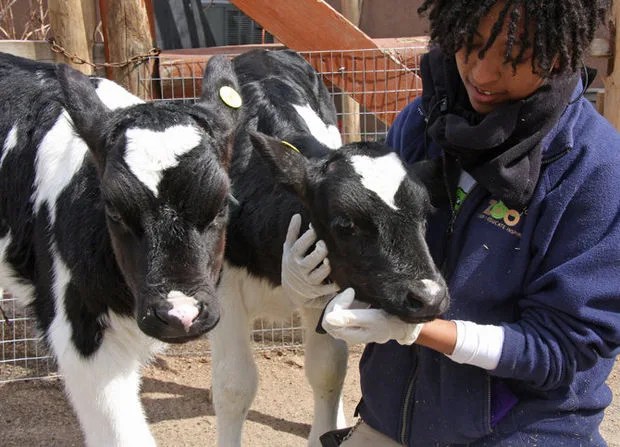
Spring has been busy for the Children’s Center at the Staten Island Zoo. Seven new lambs were born as well as two new calves. The Children’s Center resembles a farmyard with barns and railed pens that are home to not only these baby animals, but sheep, donkeys, goats, llamas, and pigs as well. Right next to the Children’s Center is the Kids Korral, a petting zoo area that is sure to put a smile on your children’s faces.
Also See: A guide to zoos, nature centers, and botanical gardens in the NYC area












